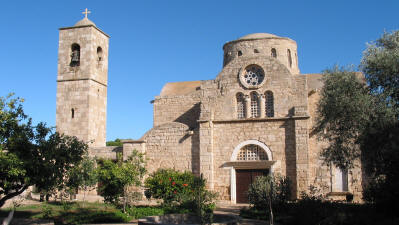
The St Barnabas monastery and Icon museum is situated close to
the
Royal Tombs
between Tuzla and
Salamis. The site consists of a church, now serving as an icon
museum, the monastery, now housing an archaeological collection, and
a chapel housing the remains of the saint.
St Barnabas was one of the founders of the independent Greek
Orthodox church, and is the patron saint of Cyprus. He,
was born in Salamis to a Jewish family of the Levi clan, (the
Levites from which the priests of the temple in Jerusalem were
chosen), who had emigrated from Syria to Cyprus. He was originally
called Sosis, a variant of Joseph.
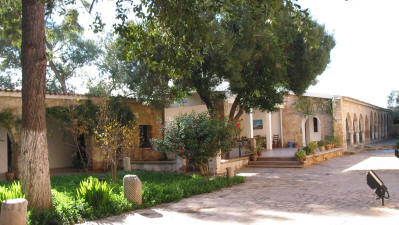 |
| The Monastery Gardens |
While undertaking a religious education in Jerusalem, Barnabas
was able to witness some of the miracles of Jesus, and in 33AD, he
took up the faith of Jesus, and gave the family properties that he
had inherited to the early church and the poor of Jerusalem.
While he was in Jerusalem he was appointed Archbishop of Salamis,
and in 45AD he returned to Cyprus, accompanied by his cousin and
follower John Mark, and by Paul of Tarsus. The plan was to convert
the sizable Jewish community to Christianity. Although he did not
have a great deal of success, he managed to impress the Roman
governor of the island, Sergius Paulus, to such an extent that he
adopted the faith. Cyprus, therefore, became the first country in
the world with a Christian ruler.
| St Barnabas |
During a second visit to he island in 75AD, Barnabas was arrested
and imprisoned in a Salamis synagogue. The same night, a mob of
Syrians stoned him to death. His remains were wrapped in a sheet and
hidden in some marshland, prior to being disposed at sea.
However, John Mark and some converted slaves from the local
temple retrieved Barnabas' remains. They secretly buried them in a
tomb beneath a carob tree to the west of Salamis, John Mark placing
a copy of Mathew's Gospel on his cousin's chest. Hotly pursued by
the Jews, who had discovered their plan, they escaped to Nicosia,
where they managed to elude their pursuers and escaped to Egypt.
The suppression of Christianity in Cyprus continued, and the tomb of
St Barnabas was forgotten. By the 5th century AD,
however, the Christian church had been re-established. The church of
Antioch, having been founded by Peter, claimed precedence over that
of Cyprus. The church on the island argued that as it had been
founded by the Apostle Barnabas, it was of equal rank.
In 477AD, Bishop Anthemios had a dream in which he saw the location
of the long lost grave. After his dream, the Bishop ordered the
opening of the tomb. There they found a body, which was identified
as Barnabas by the Gospel of St Mathew lying on his chest.
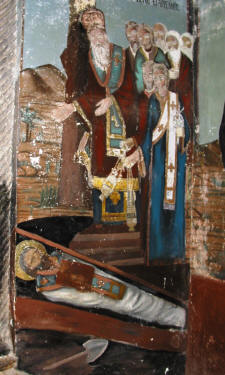 |
| The Tomb Discovered |
Post haste, the bishop set off to Constantinople (now Istanbul)
to present the bible to the Byzantine emperor, Zeno. Delighted by
this gift, the emperor granted autonomy (independence) to the church
in Cyprus. To this day, Cypriot bishops have the right to elect
their own archbishop who is entitled to wear imperial purple and
wield a sceptre instead of a pastoral staff. In addition, in
imitation of the Byzantine emperor's custom, they are allowed to
sign documents in red ink, a right which Archbishop Makarios
exercised when signing the document granting Cyprus independence
form Britain. In addition to granting independence, the
emperor funded the building of a magnificent church on the spot
where the tomb was located. It was badly damaged during the Arab
raids in the 7th century, and all that remains today are some
foundations.
The building that we see today dates from the 1750s. Once the
centre of the Cyprus Orthodox church, the monastery is still in good
condition. Outside the church there is a courtyard, surrounded on
three sides by buildings that once housed the monks and pilgrims
coming to pray at the monastery.
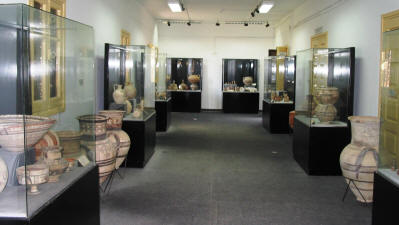 |
| The Archaeological Museum |
Over the years, the number of resident monks reduced, and by the
1950s consisted of just three monks, Charitan (born 1887), Stephanos
(born 1894), and Barnabas (born 1897). These three actual brothers
dedicated themselves to the church from 1917 onwards. They took care
of its upkeep, even building the bell tower in 1958. Most of their
time was spent painting many of the frescoes and icons that are now
on display.
After 1974, the monastery and church stayed open, and religious
ceremonies were held there, as the three brothers had stayed on.
However, by 1976, old age and illness was taking its toll, and they
decided to retire to the south.
About 100 yards from the monastery, there is a small mausoleum
built on the spot where the saint's remains were discovered. There
are 14 steps which take you down to the cave under the building
where the body of St Barnabas was hidden by his friends. The tomb
was renovated (which included building the steps) in 1953.
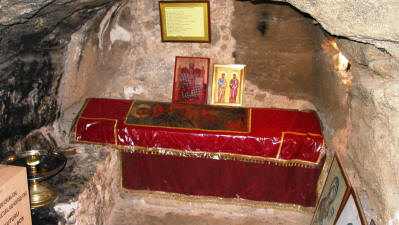 |
| The Grave of St Barnabas |
Between the mausoleum and monastery, you will see signs if a
recent archaeological dig. It is thought that the area was once part
of the necropolis of Salamis, but work is ongoing.
Although the three priests left in 1976, the monastery was
maintained, as it continued to attract visitors. In 1991, a
restoration project was started. The church has been restored
and has been turned into a more comprehensive icon museum with the
addition of new icons. The garden was redone, and the rooms of the
monastery have become an archaeological museum. The
monastery of St Barnabas is very important to the Orthodox Church,
and is considered a place of pilgrimage. The opening of the border
has seen a vast increase of the numbers of visitors to the site, and
there are frequent church services held there. June 11th
is the saint's day, and a special mass and festival was held here
till 1974. People would come to the monastery to hear readings from
the life of the saint. After a gap of 31 years, this event was
reinstated in 2005.
On most days, there is a guide present who will give free guided
tours of the monastery and museum.






No comments:
Post a Comment